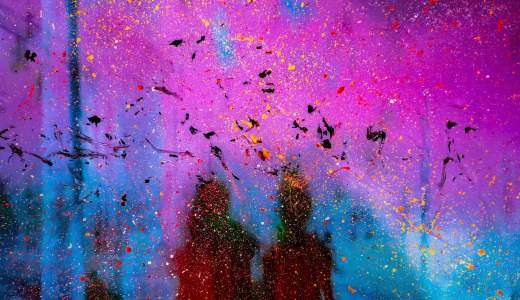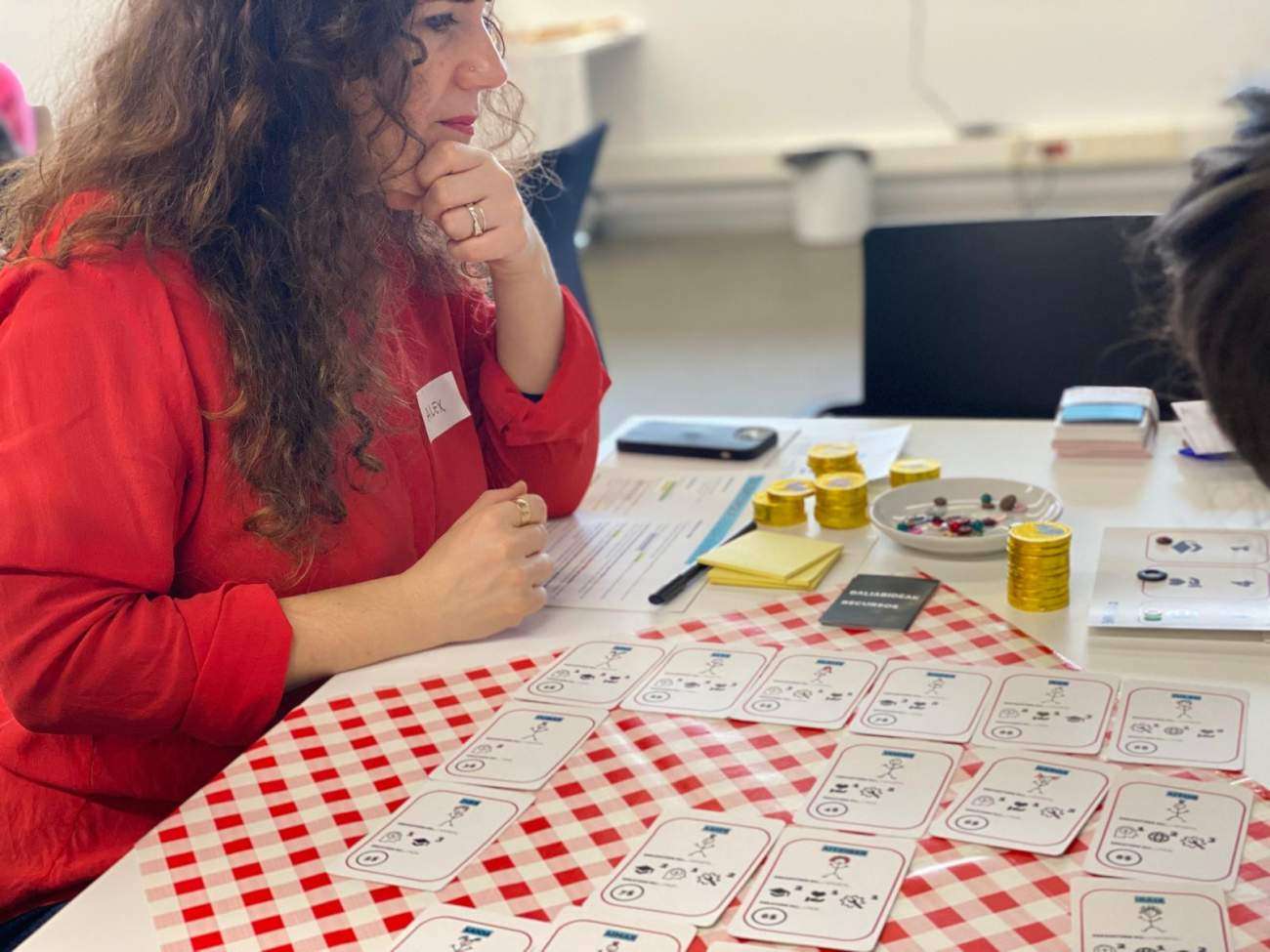Beatriz Rodríguez Morgado, a Dantzerti student, tells us about INNOVARTE, her Bachelor's Thesis Project, carried out in collaboration with Apitropik and financed by the KSIgune Connections 2023/24 call.
KSIgune: How did INNOVARTE come about?
Beatriz R.M.: Innovarte was the result of a connection between Apitropik, a design company interested in exploring how theatre could enhance their people-centred processes, and my own passion for investigating how theatre can transcend the stage and become a powerful tool. I had a thousand ideas for my Bachelor'sThesis project, all centred around applied theatre and its benefits for different fields. The connection was immediate and the magic happened. We discovered that we shared the same vision: both Apitropik and I spotted a promising area where the principles of applied theatre and design could be combined to create something new and exciting, taking advantage of the synergies of both worlds. INNOVARTE is about precisely that, about how art can drive innovation, understanding innovation as design1 that can not only solve problems, but also touch the soul and imagination.
KSIgune: What can theatre and its methodological application contribute to a design and innovation process?
Beatriz R.M.: Theatre and its methodological application can radically transform a design and innovation process. Firstly, theatre nurtures unlimited creativity and lateral thinking that allows problems to be approached from a fresh perspective. That is essential when it comes to innovation, where original solutions play a key role. Theatre also provides a deeper understanding of users. By taking on different roles and exploring different situations, you develop genuine empathy, which is crucial when designing products and services that truly respond to people's needs and desires. Theatre techniques also facilitate rapid prototyping and experimentation in a safe, playful environment, which means that ideas can be developed and effective solutions identified more quickly. Lastly, theatre greatly improves communication and collaboration within a team, by creating an environment where everyone feels comfortable in terms of contributing, meaning that ideas can blossom freely.
KSIgune: What results would you highlight from this project?
Beatriz R.M.: The results of this project were surprising but also very satisfactory. The addition of theatrical methods into the design process brought a freshness and innovative perspective that enhanced every stage of the work. We saw a marked improvement in the dynamics of the team and the users involved, where communication and cohesion improved, making for a more harmonious, productive work environment. The ideas that have come out of this approach have not only been creative, but also workable, demonstrating how the integration of theatre can lead to solutions that are both imaginative and practical. One of the most remarkable results was the theatre's ability to develop and create empathy, by understanding other people's realities and experiences in a tangible way, which made it possible to create more compassionate, user-centred solutions.
KSIgune: What was the experience of collaborating with APITROPIK while you were a student at DANTZERTI like? How has your thesis project contributed to APITROPIK?
Beatriz R.M.: Collaborating with APITROPIK while I was a student at DANTZERTI was an incredibly enriching experience. This collaboration allowed me to apply my theoretical knowledge in a real, practical context, which has been very rewarding. The exchange of knowledge was a two-way thing: I was able to bring an artistic perspective through my training at DANTZERTI, while learning about the practical applications of design in a business environment. This experience has also allowed me to broaden my vision and discover a world that I am passionate about - fusing theatre with design in a way that I had never imagined before.
My Bachelor's Thesis Project provided APITROPIK with a documented methodology that they can continue to use in future design and innovation projects, which will improve their ability to develop creative, effective solutions. This work has not only benefited APITROPIK, but has also been a source of inspiration in terms of my training and professional development, opening up new possibilities and perspectives in the field of design and innovation.
KSIgune: Where do you think INNOVARTE could go from here?
Beatriz R.M.: As INNOVARTE continues, I see the implementation and continuous evaluation of the methodologies developed as an essential step. I would like to go further and expand the work by applying the new techniques investigated in the dissertation to future Apitropik projects. This approach will make it possible to explore how theatre can be further integrated into design, opening up an avenue of ongoing collaboration where theatre has a significant place in the company's project creation processes.
Another interesting avenue for the continuation of INNOVARTE could be to reverse the perspective and explore how design can enhance the artistic creation process. In other words, instead of focusing only on how art can drive innovation in design, we could look at how innovation and design methodologies could bring value and new dimensions to the artistic process. This dual approach would not only broaden the scope of our research, but also strengthen the synergy between art and design, enhancing both fields in a creative, meaningful way.
KSIgune: What has being part of the KSIgune Connections call meant to you? What advice would you like to give to undergraduate students who are considering applying?
Beatriz R.M.: Being part of the KSIgune Connections call has been an experience that has given me the opportunity to link up with professionals and companies in the sector, broaden my network of contacts and raise my visibility in the professional sphere. It has also been a personal learning and growth experience that has allowed me to apply my knowledge in real, practical contexts.
The support of KSIgune Connections was essential in terms of achieving the depth of research. Without their support, we would not have been able to explore and develop the ideas with the same degree of intensity and rigour. Having the support of a platform such as KSIgune Connections can be critical in taking projects to the next level, as it provides resources and connections that are difficult to access otherwise. My advice to other students is to get involved. It is a unique opportunity to put what you have learned into practice, make valuable contacts and develop projects that will have a real impact.
---
References
1 Bruce Naussbaum, a leading mentor in the world of innovation and author of several best-selling books such as Creative Intelligence, observed that when we talked about innovation in the 1990s, we meant technology. When we talk about innovation now, we really mean design.
---
More information
To learn more about the projects of the KSIgune Connections 2023/24 call, go to the section Connections.
To apply for the 2024/25 call, click chere.
Current issues related news
-

Culture and Science: the driving force behind Basque innovation
ksiGuneWhen talking about innovation, the conversation often revolves around technology, patents and industrial competitiveness. However, there is one piece that remains in the shadows: Culture. Not only…
-

Tailor-made innovation for the arts, culture and creativity
ksiGuneIn 2025, KSIgune promoted a boot camp, two training and research calls, and a sectoral meeting, supporting 10 new collaboration initiatives to bring innovation to businesses and make an impact on the…
-

Konexioak 2025: your chance to create and make an impact
ksiGuneIf you study, research or work contributing to the advancement of the Arts, Culture and creative disciplines such as Architecture, Fashion or Gastronomy in the Basque Country, and you want to become…

